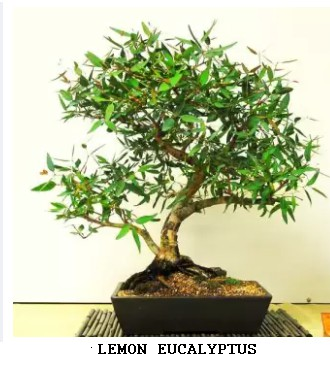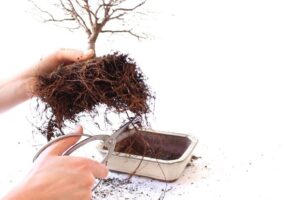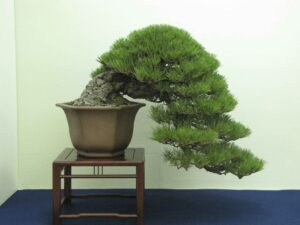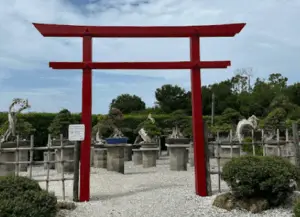
EUCALYPTUS
There are over 800 types of Eucalyptus trees, and all the types are suitable to grow as bonsai. We will focus mainly on the Eucalyptus deglupta tree, Rainbow Eucalyptus, Rainbow Gum tree, or Mindanao Gum tree. Whichever Eucalyptus you choose to make a bonsai, make sure you know their temperature requirements as most are semi-tropical and a few are low semi-hardy. The Rainbow is the only tropical Eucalyptus.
Eucalyptus are evergreens, and Rainbows are tropical evergreens. The tree has moderately broad, evergreen leaves and produces small white flowers packed with nectar. As with all Eucalyptus, the leaves contain glands that produce an aromatic oil. Despite its unmistakable fragrance, it does not produce as much oil that other eucalyptus species are well known for. It is better known for its intense color than its fragrance. It gets its name because of the unique streaks of different colors that run along the trunk and branches when the tannin-filled bark peels. These trees shed their old bark and reveal a neon green inner layer every year. Over time, as this layer is exposed to air, it ages into different colors, bright reds, oranges, blues, pinks, and purples, revealing new variegated layers of colors each time. Outside of its native tropical setting, though, the rainbow colors aren’t usually as vivid. People who grow rainbow eucalyptus as bonsai say that the trees don’t develop a faint colored bark until they are about three years old and the trunk is about two to three inches thick.
Except for the Rainbow, most Eucalyptus are native to Australia and a few to Indonesia. In their native habitats, the large evergreens can grow up to 250 feet tall and are super-fast growers, ranging 3 feet or more of growth a day. These trees can adapt to most environmental and climatic conditions except frost.
The Rainbow eucalyptus is the only eucalyptus tree indigenous to the northern hemisphere. Found mainly in Papua New Guinea, Indonesia, and the Philippines, it thrives in tropical forests that get a lot of rain, making it the only eucalyptus tree to grow in the rainforest.
INTERESTING FACT: The Rainbow is grown widely worldwide, especially in the Philippines on tree plantations, mainly for pulpwood used in making white paper.
PLACEMENT: Full sun for at least 6 hours a day. Morning sunlight is favorable for the color of leaves and bark. The trees do not act well under high sunlight for more than 8 hours a day. These trees grow best in around 70 to 85 degrees and appreciate high humidity levels. Rainbow eucalyptus, as with almost all Eucalyptus, are not tolerant of frosts. When night temps start staying in the 50-degree range, they must be protected. Temperature, humidity, and airflow all have a considerable influence on how distinct the coloration of the tannins in the tree bark will be as the Rainbow matures.
WATERING: Eucalyptus requires moist but well-drained soil. The trees can’t handle prolonged soggy or waterlogged conditions, which results in root rot, but keeping them moist will encourage the trunk and the bark to swell, encouraging more defined color stripes. Although established rainbow eucalyptus trees can tolerate some drought, they need regular watering.
FERTILIZING: Since these trees have a high speed of root growth, they do not want a high amount of nitrogen, and they aren’t fans of phosphorus either. Pot bound and starving trees develop proteoid roots that absorb more phosphorous from the soil. Those specimens can’t take any phosphorous fertilizer until they have been repotted and the proteoid roots are cut off. Take care to use a product with low phosphorous (maybe with 1.5%, in any case, not more than 3%).
PRUNING: Frequent trimming is an essential factor when growing Eucalyptus. Allow new shoots to mature before pruning them because they tend to die back if they are trimmed when they are still soft. Removing any branches suffering from damage or disease can be done in late winter or early spring.
WIRING: The fastest rate of growth is during the first ten years. Because of their growth rate, if wired, you must keep careful watch over your tree because the wires can bite in quickly, and wire marks can last for years.
REPOTTING: The best time is summer. These trees grow their root systems faster than their stems and branches, which grow much faster than other trees. Choose a pot carefully, keeping this in mind. It is recommended to choose a cone shape pot. A cone-shaped container is suitable for its high speed and complex root growth. If you select a flatter, rounded-shaped pot, roots become root-bound faster. You will have to watch more often, so the root system doesn’t overtake the pot. You will also have to repot more often as needed.
You can trim the roots 2-3 inches from the bottom and cut off any unwanted twigs, but they aren’t fans of root disturbance. They come through the process with care quite well after repotting, water, and leaving the tree in the shade for a week or two to acclimate. It can have filtered morning sunlight for a couple of hours a day during that time.
PESTS AND DISEASES: Rainbow eucalyptus trees are relatively hardy and not prone to leaf spot disease, common in humid, warm environments. Their peeling bark also helps them get rid of parasites. However, they can suffer from root rot in waterlogged conditions and are susceptible to the root fungus Armillaria.
PROPAGATION: You can propagate a eucalyptus from seed and cuttings. If growing from seed, start it in a big pot. The bigger, the better because Eucalyptus do not like their roots played with a lot, and in a big, huge, humongous pot the seed can grow like a weed and form a sound root system. You can propagate a Rainbow from cuttings but take cuttings only from very young trees. Cuttings taken from seedlings and trees younger than five years root well, but cuttings taken from older trees usually fail to root due to a chemical that inhibits rooting within older specimens.
It is recommended you buy a Eucalyptus tree from a trusted nursery. It is better to buy a small tree. A grown plant is harder to handle and shape. A plant with a height of around 5 to 7 inches might be the best choice as they grow very fast.
Written by Charlotte Field
References: Bonsai Empire, BonsaiYard, Kelly Corbett, One Earth, The Spruce



